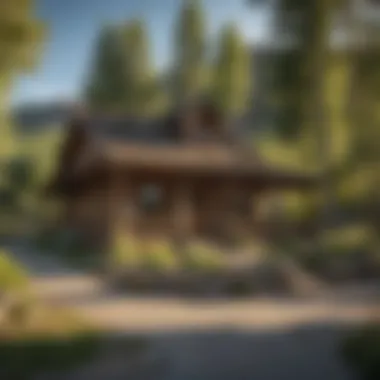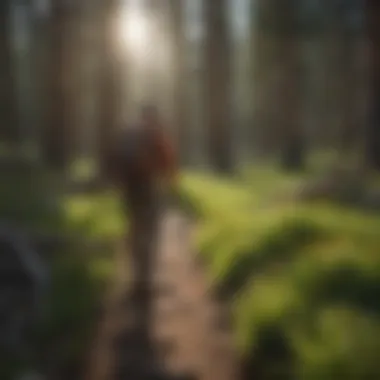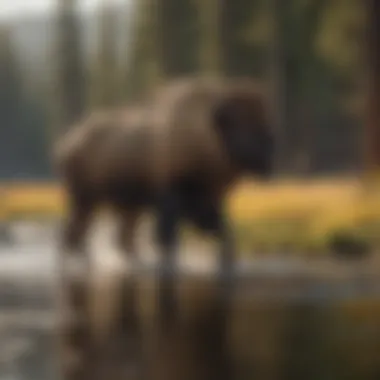Discovering the Charms of Cody, Wyoming


Intro
Cody, Wyoming, situated near the eastern entrance of Yellowstone National Park, offers an intriguing glimpse into the intersection of nature and culture. The city ranks as a focal point for understanding forestry practices in Wyoming, as the surrounding landscapes embody both natural splendor and historical significance. This exploration aims to illuminate the essential aspects of Cody's geography, cultural history, and its commitment to sustainable woodland management.
In Cody, the vast expanses of forest are not just backgrounds to recreational activities but play a critical role in the regional economy and ecology. The management of these forests stands as a testament to a broader narrative about conservation and sustainability. As we delve into the details of forestry practices in Cody, we will see how these efforts balance natural beauty with responsible stewardship.
Preamble to Cody, Wyoming
Cody, Wyoming, stands as an emblematic representation of the American West, notable for its stunning landscapes and rich cultural tapestry. It serves as a gateway to natural wonders, particularly Yellowstone National Park, while also retaining a distinct historical essence. Understanding the significance of Cody in the broader context of Wyoming is crucial in appreciating its unique characteristics and contributions to both tourism and local culture.
Cody is not only a town that attracts visitors with its picturesque views but also exemplifies sustainable practices and a commitment to preserving its heritage. The town's duality as a natural haven and cultural landmark makes it worthy of in-depth exploration. In this section, we will look closely at the geographical attributes and the historical factors that shaped Cody's identity.
Geographical Overview
Cody is situated in North-Central Wyoming, enclosed by the majestic Absaroka Mountains to the west and the scenic Shoshone National Forest to the north. The town lies at an elevation of about 5,300 feet, which contributes to its diverse climate and unique environmental conditions.
This geographical positioning endows Cody with a variety of topography suitable for various recreational activities. From rolling hills and valleys to expansive plains, nature lovers will find plenty to explore. Rivers such as the Shoshone add to the biodiversity of the area, providing habitats for various wildlife and opportunities for recreational activities.
The proximity of Cody to Yellowstone National Park is another significant geographical aspect. This closeness makes Cody a prime location for tourists looking to explore both the geological marvels of the park and the local culture.
Historical Significance
Cody's history is intrinsically linked to the expansion of the American frontier. Founded in 1896 by the showman William Frederick “Buffalo Bill” Cody, the town evolved rapidly due to its positioning as a supply hub for travelers heading to Yellowstone. The impact of Buffalo Bill’s influence can still be felt today, as much of Cody's identity remains rooted in its Wild West heritage.
The construction of the Buffalo Bill Dam in 1910 was a pivotal moment for the town. Not only did it provide irrigation and hydroelectric power, but it also established Cody as a center of agriculture and community growth. This infrastructure allowed the town to cultivate a diverse economy, strengthening its foundation.
Additionally, the historical significance of Cody extends beyond frontier life. The area has witnessed the interplay of Native American cultures and settlers, each contributing unique narratives that shape the town's collective memory. Recognizing these historical layers adds depth to the understanding of Cody's identity.
"Cody's historical lineage is a tapestry woven with tales of exploration, conflict, and unity."
By glancing at the geographical and historical dimensions of Cody, one begins to grasp the town's essence as a microcosm of the American experience.
Cody's Cultural Heritage
Cody's cultural heritage is a tapestry woven from diverse influences, reflecting the region's complex history and its evolution over time. The intersection of Native American traditions and the pioneering spirit of early settlers forms the foundation of this unique cultural landscape. By understanding these elements, one can appreciate the significance of Cody not only as a historical site but also as a living community that honors its past while moving toward its future. This section delves into those influences and events that shaped Cody's identity, emphasizing their relevance today.
Native American Influences
The story of Cody begins long before it was established as a town. The Shoshone and Crow tribes inhabited the region for centuries, their cultures deeply connected to the land. They utilized the bountiful resources around them for sustenance and crafted a way of life intertwined with nature.
The artistic expressions of these tribes are evident in the artifacts found in the area, showcasing their connection to the environment. Traditional practices such as hunting, fishing, and gathering are essential aspects of their heritage. The spiritual beliefs and ceremonies of Native American tribes also offer insight into their profound relationship with the surrounding landscape. By recognizing these influences, one acknowledges the cultural depth that precedes Cody’s establishment as a town and the need to respect these ancestral traditions.
Settlers and the Wild West
As the railroad expanded into Wyoming in the late 19th century, settlers arrived in search of new opportunities. This period marked a significant transformation in Cody and the surrounding areas. The town became a focal point for both commerce and adventure, symbolizing the Wild West.
The interactions between settlers and Native Americans often led to a complex and sometimes contentious relationship. Despite this, the settlers brought new agricultural practices and economic development, laying the groundwork for a growing community. Events such as the establishment of the Cody Nite Rodeo reflect the legacy of this era.


Cody became known as a Wild West town, where rodeos and cowboy culture flourished. The influence of this period still echoes today through festivals and celebrations that honor the town's history.
Cody's Founding and Development
Cody was founded in 1896 by William Frederick Cody, also known as Buffalo Bill, who envisioned a community that celebrated the spirit of the American West. His ideas went beyond just building a town; it was about fostering a way of life that incorporated both the rugged spirit of the settlers and the rich cultural heritage of Native Americans.
As Cody developed, it attracted tourists seeking the authentic experience of the Old West. The founding of the Buffalo Bill Center of the West stands as a testament to this vision, preserving and sharing the narratives of both Native Americans and pioneers. The town has evolved but maintains a commitment to honoring its roots through various cultural events, festivals, and educational programs.
In summary, Cody's cultural heritage is a blend of influences that tell the story of resilience, adaptation, and respect for the land. Understanding this heritage not only enriches the visitor experience but also encourages a more profound appreciation for the community's commitment to sustainability and responsible stewardship of its historical and natural resources.
Key Attractions in Cody
In Cody, Wyoming, a number of key attractions stand out, underlining the town's unique identity. These sites offer a mix of cultural heritage and outdoor experiences, enhancing the visitor’s experience. As a comprehensive resource, this article will explore attractions that contribute not only to tourism but also to a deeper understanding of the region's history and environmental practices.
Buffalo Bill Center of the West
At the heart of Cody’s cultural landscape lies the Buffalo Bill Center of the West. This institution is pivotal in preserving and presenting the history of the American West. Established in 1917, it offers an extensive collection of art, artifacts, and exhibits focusing on the life and legacy of William F. Cody, known popularly as Buffalo Bill.
Visitors can explore five museums under one roof. These include the Whitney Gallery of Western Art, the Buffalo Bill Museum, and the Plains Indian Museum. Each part provides unique insights into the region's history and diverse cultural aspects. Educational programs and exhibitions cater to various audiences, making it a vital resource for those looking to understand the nuances of the West.
Additionally, the Center hosts special events and public lectures that further engage the community. This setting supports not only tourism but also substantive discussions on cultural and historical themes.
Cody Nite Rodeo
The Cody Nite Rodeo is an iconic event. This summer tradition, established in 1938, showcases the rich cowboy culture that pervades the area. It is the longest-running nightly rodeo in the United States and occurs every night during the summer months.
The rodeo features a variety of events such as bull riding, barrel racing, and tie-down roping. These competitions highlight both the skill of the riders and the spirit of the Wild West. Beyond the entertainment value, the rodeo reflects the historical significance of cattle ranching and cowboy life in Wyoming.
Attending the Cody Nite Rodeo is more than mere spectator sport; it connects visitors to the region's roots. It offers a lens through which one can view the heritage of rural America. This makes it an essential component of Cody’s attractions.
Local Art and Culture
Cody boasts a vibrant local art and culture scene that enhances its appeal. Numerous galleries and art studios display the works of local artists who draw inspiration from the natural surroundings. The art ranges from traditional landscape paintings to contemporary pieces that reflect modern interpretations of Western themes.
The annual Buffalo Bill Art Show and Sale further highlights local talent, bringing artists together to celebrate their work while contributing to local conservation efforts. Events like these create a sense of community and encourage collaboration among artists, residents, and visitors.
Furthermore, local arts initiatives often focus on sustainability. By promoting environmentally conscious practices, these initiatives have cultivated a unique community identity. The blend of creativity and respect for the environment demonstrates the depth of Cody's commitment to both culture and nature.
"Cody's attractions are not just places to visit; they embody the spirit and history of the American West, fostering a connection to the landscape and its heritage."
Understanding the key attractions in Cody is essential for those looking to experience the heart of Wyoming. They offer insights into the region's past and present, enriching both the visit and the visitor's understanding of this remarkable area.
Outdoor Activities and Natural Attractions
Outdoor activities and natural attractions play a crucial role in enhancing the overall appeal of Cody, Wyoming. This region is known for its breathtaking landscapes and abundant wildlife, making it an ideal location for both residents and tourists to engage with nature. The connection between the community and its outdoor environment fosters a unique identity for Cody, characterized by adventure and exploration. Exploring these elements provides various benefits, including mental and physical well-being, environmental awareness, and economic opportunities for local businesses.
Exploring Yellowstone National Park


Yellowstone National Park, located just a short drive from Cody, embodies one of the most iconic natural wonders in the United States. It covers a vast area rich with geothermal features, diverse flora, and fauna. Visiting Yellowstone offers extensive exploration options for those interested in ecology, geology, and conservation studies. The park's accessibility from Cody makes it an excellent day trip or extended adventure for outdoor enthusiasts.
Some significant features of Yellowstone include:
- The famous Old Faithful geyser
- Yellowstone Lake, providing excellent opportunities for boating and fishing
- The diverse wildlife, including bison, elk, and wolves
Understanding Yellowstone's ecology and management policies can inform responsible practices among visitors, ensuring that these natural resources are preserved for future generations.
Hiking and Wildlife Observation
Cody serves as a strategic gateway to numerous hiking trails and wildlife observation areas. The region's varied terrain, which encompasses mountains, river valleys, and forests, provides hiking opportunities tailored to different skill levels. Trails like the Beartooth Highway offer picturesque views, while others lead to secluded spots perfect for observing wildlife in their natural habitats. Wildlife observation is a fascinating aspect of outdoor activities. Visitors can document species migrations while following ethical practices to avoid disturbing the animals. Remember to maintain a safe distance from wildlife and to follow local guidelines about food storage and campsite management.
Fishing and River Sports
Fishing is a prominent outdoor activity in Cody, thanks to the ample freshwater sources and rivers ideal for various species. The Shoshone River, in particular, offers excellent fishing prospects. Fishermen can expect to catch trout and other species, making it a popular destination for both seasoned anglers and novices. River sports, including kayaking and rafting, also attract those looking for adventure on the water. These activities not only promote relaxation and enjoyment but also highlight the importance of water quality and habitat conservation.
Ultimately, the combination of fishing and river sports in Cody contributes to a vibrant community that thrives on outdoor recreation, encouraging sustainable practices while enjoying nature's bounty.
"Cody's outdoor activities provide a seamless blend of adventure, environmental stewardship, and cultural appreciation, making it a key element of what defines this region."
Engaging with outdoor activities in Cody is not merely a leisure pursuit but a pathway towards fostering respect for natural resources and cultural heritage. By promoting responsible practices, Cody's community and visitors can ensure this remarkable environment flourishes for years to come.
Sustainable Practices in Cody
Sustainable practices in Cody, Wyoming, play a pivotal role in both preserving the natural environment and enhancing the quality of life for residents. In a region that balances outdoor activities and tourism with a need for conservation, the integration of sustainability into various projects is significant. It supports local ecosystems, encourages responsible resource management, and fosters a community spirit that values environmental stewardship. In this section, we will explore local conservation efforts alongside community engagement in forest stewardship initiatives.
Local Conservation Efforts
Cody's local conservation efforts are centered around protecting the unique natural landscapes and flora and fauna that define the area. Organizations such as the Cody Conservation District work diligently to promote sustainable land management practices. These initiatives include educational programs aimed at both residents and visitors about the importance of biodiversity and habitat protection.
Several key elements characterize the conservation efforts in Cody:
- Wildlife Protection: Strategies are in place to protect local wildlife, including efforts to manage invasive species that threaten native ecosystems.
- Water Resource Management: Sustainable practices focus on maintaining water quality in lakes and rivers, crucial for both wildlife and human usage.
- Public Awareness Campaigns: Various campaigns encourage residents to participate in conservation activities, fostering a sense of responsibility towards the environment.
"Protecting the natural environment is not just a duty; it is essential for the future generations of Cody."
The benefits of these efforts are not only ecological but also economic. A well-conserved area attracts eco-tourism, which can significantly contribute to local businesses and create job opportunities.
Community Engagement in Forest Stewardship
Community engagement plays a strong role in Cody's approach to forest stewardship. This involves residents, local organizations, and government agencies working collaboratively. The goal is to maintain healthy forests while simultaneously promoting sustainable recreational practices.
There are a few important aspects of community involvement in forest stewardship:
- Education and Training: Local workshops educate the community on forest ecology and management techniques. This empowers them to take an active role in conservation efforts.
- Volunteer Programs: Residents often participate in clean-up and restoration projects, showcasing a collective commitment to their environment.
- Partnership with Experts: Collaboration with forestry professionals helps ensure that strategies implemented are based on scientifically backed data.
Engaging the community is beneficial for a number of reasons. It fosters a stronger connection between people and their environment, promotes responsible use of forest resources, and cultivates a culture of stewardship among current and future generations. Living in harmony with nature remains a guiding principle for Cody's community members, illustrating how sustainable practices can be incorporated into daily life.
This emphasis on sustainability not only reflects a commitment to the natural beauty of Cody but also sets a precedent for other regions. As Cody navigates its development, maintaining these sustainable practices will be critical for future growth.
Cody's Economy and Development
Cody, Wyoming, demonstrates an economy that reflects both the natural and cultural richness of the region. This section explores the ways in which economic activities shape the community and enhance the quality of life for its residents. Understanding Cody’s economic landscape is essential, as it provides insight into the interdependence of tourism, local businesses, and sustainable development.
Tourism Impact


Tourism is a driving force in Cody's economy. The town attracts visitors seeking a taste of the Wild West, natural beauty, and cultural heritage. Notable attractions such as the Buffalo Bill Center of the West and the Cody Nite Rodeo draw thousands each year. According to local tourism statistics, the influx of visitors significantly affects businesses in the area. Hotels, restaurants, and shops experience heightened activity during peak tourist seasons, bolstering the local employment market.
The tourism impact stretches beyond direct financial benefits. It also enhances local infrastructure and services. Roads, parks, and public spaces receive attention and improvements due to the needs of visitors. Increased tourism stimulates local pride and community involvement, encouraging residents to engage in preserving the unique culture of their town. This engagement contributes to a sense of identity and belonging among locals, making tourism a critical pillar of Cody's economy.
"Tourism not only brings economic benefits but also fosters a sense of community and cultural preservation."
Local Business Landscape
Cody's local business landscape presents a blend of established enterprises and emerging ventures. The economy is diverse, featuring businesses in several sectors. These range from retail and hospitality to agriculture and art. Independent shops selling locally sourced goods and crafts provide visitors with a one-of-a-kind shopping experience, whereas larger businesses support the economy via employment.
Many local businesses prioritize sustainability. They rely on eco-friendly practices and locally sourced materials. This not only meets the growing demand for green products but also supports the community's commitment to preserving its natural resources. Furthermore, local businesses often collaborate with each other, creating a network of support that enhances economic resilience.
The landscape is also influenced by seasonal fluctuations, largely affected by tourism patterns. During the summer months, businesses may experience increased sales, while in winter, they adapt to cater to a smaller base of residents and local visitors. This adaptability is crucial for long-term sustainability in Cody's economy.
In summary, Cody's economy is characterized by its reliance on tourism and a strong network of local businesses. This interrelationship supports not only the financial well-being of the area but also enhances cultural and community ties, reinforcing the town's commitment to sustainable practices.
Living in Cody: A Quality of Life Assessment
Assessing the quality of life in Cody, Wyoming, provides insight into what can be expected if one chooses to relocate or spend an extended period there. Several factors contribute to the overall experience of living in this unique town. It is essential to consider these aspects carefully, especially for those who appreciate a balance between urban amenities and a connection to nature.
Community and Lifestyle
Cody embodies a strong sense of community, characterized by friendly residents who take pride in their town. There is a noticeable small-town vibe where people know each other, fostering a spirit of cooperation and support. This can make newcomers quickly feel welcomed and integrated into the social fabric.
The lifestyle in Cody often revolves around outdoor activities due to its proximity to stunning natural landscapes. Many residents take advantage of nearby parks and recreational areas for activities like hiking, fishing, or simply enjoying nature. This propensity for outdoor living encourages a healthier lifestyle, promoting physical fitness and mental well-being.
However, it is important to acknowledge that the job market in Cody can be limited. Many residents work in tourism, hospitality, or retail, reflecting the town's focus on serving visitors. This might impact long-term residents seeking career advancement in specialized fields. Hence, individuals considering moving to Cody might need to weigh the benefits of a tranquil lifestyle against potential limitations in employment opportunities.
Education and Health Services
Access to quality education and health services is a significant consideration for families relocating to Cody. The school district in Cody prioritizes educational excellence, offering a variety of programs for students. Schools like Cody High School provide solid academic foundations and extracurricular activities, focusing on preparing students for future challenges. Community engagement in educational initiatives is notable, promoting a culture of support around local schools.
In terms of health care, Cody is home to the Cody Regional Health Hospital, which offers a range of services from emergency care to specialized treatment. While the facility is equipped to handle general health needs, residents may have to travel to larger cities for more extensive medical services or specialized care. This factor is essential for those with chronic health conditions or specific medical needs.
Ending: The Future of Cody
The future of Cody, Wyoming, stands at a critical juncture as the community navigates its identity amid rapid change. This conclusion examines the essential elements that will define Cody's trajectory. Sustainable growth and preserving cultural heritage are paramount to maintaining the character of this unique region. As pressures from tourism and development increase, local stakeholders must consider balancing economic opportunities with environmental stewardship.
Sustainable Growth and Development
Sustainable growth in Cody requires thoughtful planning, integrating economic development with ecological preservation. Key considerations include:
- Infrastructure Improvements: Modernizing transportation and utility systems is vital. Enhanced infrastructure can support both residents and visitors while reducing environmental impact.
- Community-Based Initiatives: Engaging residents in decision-making processes fosters a sense of ownership. Programs will encourage local businesses to adopt sustainable practices, aligning profit with environmental consciousness.
- Tourism Management: As a destination, Cody must manage the influx of tourists effectively. Strategies such as promoting off-peak visits can help alleviate pressure on natural resources while providing visitors with a rich experience.
These approaches not only aim to sustain quality of life but also enhance Cody’s appeal as a travel destination without compromising the integrity of its environment.
Preserving Cultural Heritage
Cody's cultural heritage is a dynamic aspect that requires respect and protection. Preserving this heritage involves:
- Historical Site Protection: Maintaining landmarks that signify Cody's history is crucial. These sites serve as educational resources for both locals and tourists, deepening appreciation for the community’s past.
- Culturally-Informed Practices: Engaging Native American communities in cultural expressions reinforces their contributions to local heritage. It is essential to honor traditional practices, art, and community stories.
- Celebration of Local Arts: Promoting local artists and cultural events enhances community identity. The arts can serve as a means to reflect the diverse narratives that shape Cody, enriching its cultural fabric.
Preserving heritage is not merely about remembering the past; it is about informing the future.
Cody's ability to thrive in future challenges will depend on the commitment to uphold both sustainable development and the rich tapestry of its cultural identity. This dual focus can set the standard for other similar communities eager to embrace change while respecting their roots.















